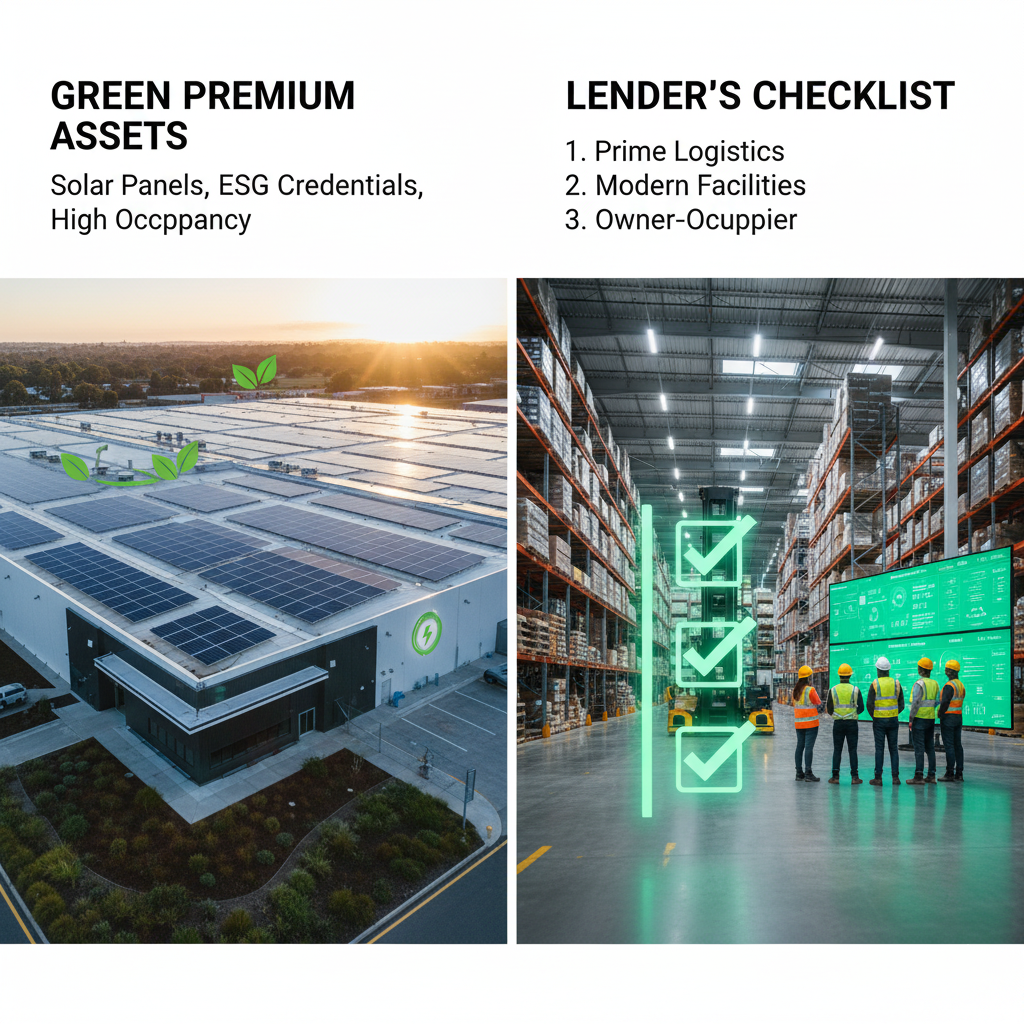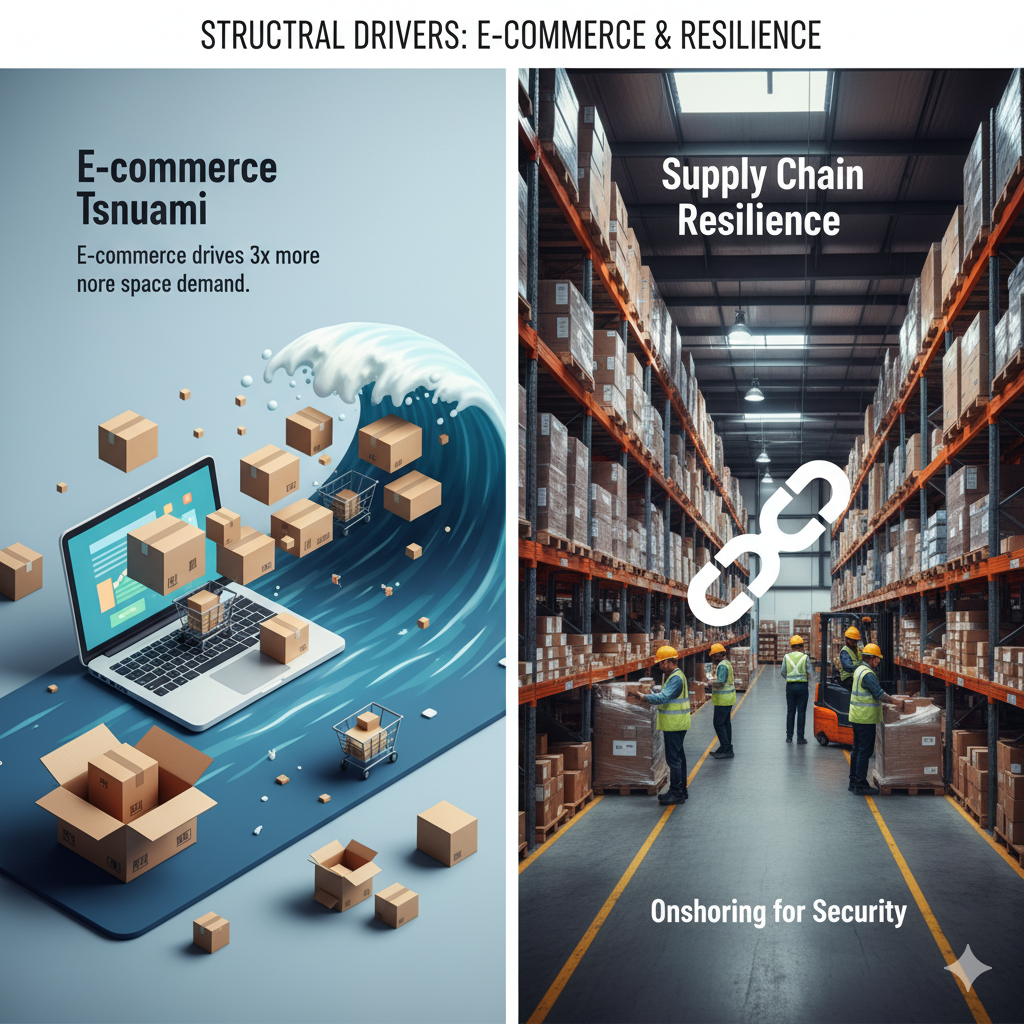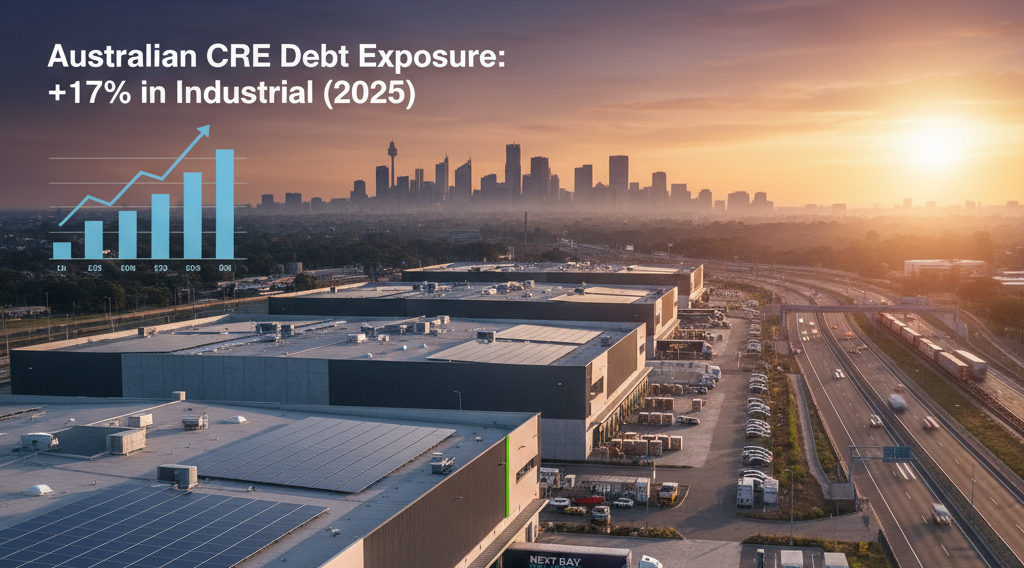While residential property headlines continue to dominate mainstream media, I’m witnessing something remarkable happening in Australia’s industrial property investment landscape (something my savvy clients are quietly capitalising on). What’s that? Industrial property investment has become the most sought-after asset class among institutional lenders, and for very good reasons.
In my 15+ years help Australian business owners and investors access commercial property finance, I’ve never seen lender appetite for industrial assets this strong. If you’re considering industrial property investment, expanding your logistics operations, or adding warehouse assets to your portfolio, understanding where lenders are actively deploying their capital right now could save you tens of thousands in interest costs and unlock opportunities you didn’t know existed.
Why Industrial Property Investment Has Become Australia’s Hottest Asset Class
The numbers tell a compelling story. Australia’s industrial and logistics investment universe has grown from $286 billion to become the nation’s largest commercial property sector, now valued at over $400 billion and continuing to expand rapidly.
What’s driving this unprecedented growth in industrial property investment?
Unlike speculative property booms of the past, the industrial property investment surge is underpinned by three structural economic shifts that show no signs of reversing:
1. The E-Commerce Revolution Reshaping Warehouse Demand
E-commerce now represents 15% of Australia’s retail sales—four years ahead of pre-pandemic forecasts—and this shift has created an insatiable appetite for modern warehouse property finance.
Here’s what most business owners don’t realise: online retail requires three times the distribution space of traditional retail. Every parcel delivered to your door needs staging areas, sorting facilities, and last-mile distribution centres.
In my experience working with lenders, this translates into one critical advantage for industrial property investment: tenant stability. Major e-commerce players, national retailers, and logistics companies offer long-term lease commitments that traditional retail tenants simply can’t match. According to the Property Council of Australia, industrial and logistics properties now represent the most resilient commercial asset class, with vacancy rates consistently below 3% nationally.
What I’m seeing for borrowers: If you’re financing a warehouse with a blue-chip tenant, expect competitive rates and higher loan-to-value ratios (LVRs) than you’d achieve with comparable retail or office properties. This makes industrial property investment particularly attractive for both owner-occupiers and investors seeking stable, long-term returns.
2. Supply Chain Resilience Driving Manufacturing and Distribution Finance
The pandemic exposed critical vulnerabilities in Australia’s supply chains. The response? Businesses across every sector are now holding larger domestic inventory—shifting from “just-in-time” to “just-in-case” inventory management.
This fundamental business strategy change has created sustained demand for larger high-clearance warehouses for bulk storage, modern distribution centres with advanced automation capability, temperature-controlled facilities for pharmaceutical and food logistics, and manufacturing facilities as businesses onshore production.
From a lender’s perspective (and I speak with credit managers weekly), properties serving this supply chain resilience trend receive preferential treatment because they solve a structural business need rather than being speculative investments. I’ve seen manufacturing facility finance applications backed by established businesses demonstrating inventory growth receive faster approvals and more competitive terms than virtually any other commercial property type.
3. Infrastructure Investment and Industrial Land Scarcity Creating Value
Population growth combined with limited appropriately-zoned industrial land (especially near major metropolitan areas) means supply simply cannot keep pace with demand.
I’m watching critical infrastructure projects amplify this trend, including Western Sydney Airport (opening 2026), Melbourne’s North East Link, Brisbane’s Cross River Rail, and Port of Melbourne expansions. When major transport infrastructure is developed, I’ve seen industrial property values in surrounding corridors appreciate 30-40% within three years. Lenders recognise this, which is why industrial property investment finance in these growth corridors receives premium treatment.
The financing advantage I’m securing for clients: Strong rental growth in these precincts provides excellent loan serviceability buffers. When your industrial property investment generates rental income growing 8-12% annually, lenders have greater confidence in your ability to service debt even if business conditions tighten.
Where Lenders Are Actively Deploying Capital for Industrial Property Investment
Not all industrial properties receive equal treatment from lenders. In my daily conversations with credit teams across major banks and specialist lenders, I’ve learned exactly which asset types are receiving preferential rates and higher LVRs for industrial property investment. This knowledge can dramatically improve your financing outcome.
Prime Logistics Facilities: The Lender’s “Blue Chip” Investment
What Lenders Love |
Why It Matters |
|---|---|
Modern facilities over 20,000 sqm |
Economies of scale attract quality tenants |
Strong WALE (Weighted Average Lease Expiry) of 5+ years |
Guaranteed income stream reduces risk |
Established industrial estates with infrastructure |
Proven location with tenant demand |
Clear span warehouses with modern specifications |
Maximum flexibility for future tenants |
Current market rates I’m securing for logistics hub finance:
- Big 4 banks: From 5.85% for prime assets
- Regional banks: Slightly higher interest rates (but not by as much as some people think) with personalised service
- Non-bank specialist lenders: Up to 70% LVR available
Why this matters: Just last month, I helped a Melbourne-based logistics company secure $4.2M at 5.85% for a modern 25,000 sqm warehouse with a 7-year lease to a national retailer. A comparable retail property would typically attract rates 0.50-0.75% higher and maximum 70% LVR.
“Green Premium” Industrial Assets: ESG-Driven Lending Advantage

Environmental, Social, and Governance (ESG) criteria now directly impact commercial lending decisions. I’m seeing industrial properties with sustainability features receive measurably better terms:
Green Feature |
Lender Benefit |
Typical Rate Advantage |
|---|---|---|
Rooftop solar (minimum 100kW) |
Reduced operating costs, ESG quota |
0.15-0.25% discount |
LED lighting & energy management |
Lower tenant costs, marketability |
0.10-0.15% discount |
Green Star or NABERS rating |
Premium tenant attraction |
0.20-0.30% discount |
EV charging infrastructure |
Future-proofed facility |
Higher LVR (up to 5% more) |
Banks have ESG lending quotas to meet, creating fierce competition for environmentally-credentialled industrial assets. In my experience, we’re seeing rate discounts of 0.15-0.30% for certified green buildings, higher LVRs (up to 5% more) for sustainable facilities, faster approval processes due to preferential credit assessment, and access to “green loan” products with additional features.
Real example from my recent deals: A Sydney food distribution facility with a 150kW solar array and 5-star NABERS rating secured cold storage facility finance at 5.85%; significantly below market rates for comparable non-green assets.
Owner-Occupier Industrial Finance: The “Low-Risk” Sweet Spot
When business owners purchase their own industrial premises, I’ve learned that lenders view this through a completely different risk lens than investment properties.
Why I consistently see lenders prefer owner-occupier industrial property investment: There’s dual security with both business operations and property equity, the owner’s personal commitment to business success is evident, there’s reduced vacancy risk (owners won’t evict themselves), and these loans have better long-term credit performance history.
Loan Type |
Typical LVR |
Rate Range |
Key Advantage |
|---|---|---|---|
Owner-Occupier Industrial |
Up to 85% |
5.80% - 8.35% |
Business assets as additional security |
Investment Industrial |
70% |
6.10% - 8.20% |
Rental income focus |
SMSF Industrial |
70% - 80% |
6.25% - 8.20% |
Tax-effective structure |
Strategic opportunity I’m leveraging for clients: A manufacturing business purchasing a $3.5M factory for expansion can often achieve better terms than an investor buying the same property (even if the investor has stronger personal finances). The business-property alignment significantly reduces lender risk, and I use this to negotiate aggressively for owner-occupier industrial property investments.
Geographic Focus: Where Industrial Property Investment Gets Preferential Treatment

Through my conversations with lenders, I’ve learned that their appetite varies dramatically by location. Understanding regional preferences can be the difference between approval and decline, or between 6.5% and 7.5% interest rates for your industrial property investment.
Sydney’s Industrial Corridors: Premium Pricing, Aggressive Competition
Precinct |
Infrastructure Driver |
Typical LVR |
Rate Range |
|---|---|---|---|
Outer South-West (Moorebank, Ingleburn, Prestons) |
M5/M7 access, rail freight |
70% |
6.10% - 8.20% |
Western Sydney Airport corridor (Badgerys Creek, Kemps Creek) |
New airport (2026), motorway links |
60% - 80% |
5.80% - 8.35% |
M7 Logistics precinct (Eastern Creek, Huntingwood) |
Established logistics hub |
70% |
5.85% - 8.20% |
Major banks are actively seeking quality Sydney industrial property investment opportunities. Recent CBRE research shows Sydney represents 44% of Australia’s total industrial property capital stock, creating intense lender competition that I leverage for my clients. The Reserve Bank of Australia’s commercial property data confirms that banks’ exposure to industrial and logistics properties has grown 17% year-on-year, significantly outpacing other commercial sectors.
Melbourne’s Growth Zones: Value + Infrastructure Investment
I’m seeing exceptional opportunities in Melbourne’s western corridor (Truganina, Derrimut, Laverton North), northern growth areas (Craigieburn, Epping, Somerton), and south-east traditional hubs (Dandenong, Hallam, Keysborough).
The North East Link and Westgate Tunnel projects are driving significant industrial development. In my experience, properties within 10km of these infrastructure projects receive enhanced lender interest, and Melbourne industrial properties often achieve 0.10-0.25% better rates than comparable Sydney assets due to lower entry prices and strong yield compression trends.
Brisbane & Regional Queensland: The High-Growth Opportunity
From my recent dealings, I’m seeing emerging industrial finance hotspots in Brisbane West (Wacol, Richlands, Berrinba), the northern corridor (Lytton, Pinkenba, Eagle Farm), Gold Coast logistics (Yatala, Coomera), and Toowoomba distribution (established inland hub).
Brisbane industrial vacancy rates have fallen to 2.1%, creating strong rental growth that lenders reward with competitive terms. I’ve secured recent yield compression that has Brisbane industrial assets receiving similar lender appetite to Sydney assets, something unthinkable just two years ago.
Adelaide & Perth: Selective Opportunities with Specialist Lenders
These markets require a more strategic approach based on what I’ve learned. Adelaide has strong infrastructure spending, automotive and defence manufacturing growth, and lower land costs creating development opportunities. Perth is benefiting from resources sector recovery driving logistics demand, Port Hedland and Fremantle industrial growth, and emerging e-commerce distribution requirements.
In my experience, major banks can be conservative in these markets, but regional banks and non-bank lenders actively seek well-structured distribution centre finance deals—often offering comparable rates to eastern seaboard deals when the fundamentals are right.
How to Position Your Industrial Property Investment for Optimal Finance Terms
Understanding what lenders want isn’t enough, you need to structure your application to highlight the exact factors that reduce perceived risk and increase lender competition for your industrial property investment. Here’s what I’ve learned works best.
Strategy 1: Lead With Structural Demand Evidence
When I approach lenders for industrial property loans, I don’t just present financials. I demonstrate how the property aligns with structural economic trends. This approach has consistently delivered better outcomes for my clients.
Property Type |
Evidence That Strengthens Application |
What Lenders Want to See |
|---|---|---|
E-commerce-linked properties |
Tenant profile showing e-commerce exposure, last-mile delivery advantages |
Long-term lease commitments from growth sectors |
Supply chain assets |
Inventory growth trends, strategic supplier/customer location |
Tenant commitment to holding domestic stock |
Infrastructure-adjacent |
Project timeline, proximity data, independent rental forecasts |
Transport connectivity creating competitive advantage |
Why this works in my experience: Lenders assess future serviceability risk. When you demonstrate your property solves a structural demand issue, you’re proving income stability that traditional financial metrics alone can’t capture.
Strategy 2: Leverage Multi-Lender Competition
In my 15+ years in commercial finance, I’ve learned that the industrial finance market is characterized by significant lender variation. Different lenders have different risk appetites for specific industrial property types, geographic preferences and local market knowledge, LVR limits based on internal portfolio allocation, and rate competitiveness depending on funding costs.
The broker advantage I provide: At Smart Business Plans, I maintain active relationships with 60+ commercial property lenders, including many specialists who don’t work directly with the public. This allows me to identify which lenders are actively seeking industrial deals in your location, create competition by presenting your application to multiple suitable lenders simultaneously, negotiate terms using competitive tension to improve rates, LVRs, and conditions, and access private commercial lenders and non-banks that complement bank options.
Real outcome from last month: A Brisbane logistics business was initially quoted 7.2% at 65% LVR from their existing bank. I identified three competing lenders, ultimately securing 5.85% at 85% LVR—saving them $47,000 in interest in year one and reducing deposit requirements by $350,000.
Strategy 3: Emphasise Asset Quality and Specification
I’ve learned that modern lenders increasingly use sophisticated property assessment models. Understanding the technical specifications that trigger better lending outcomes is crucial:
Property Feature |
Minimum Standard |
Premium Standard |
Lender Impact |
|---|---|---|---|
Clear span height |
10m |
12m+ |
Higher valuation per sqm |
Container access |
Standard dock doors |
Multiple dock levelers + B-double access |
Attracts quality logistics tenants |
Power supply |
200A three-phase |
400A+ three-phase |
Manufacturing capability = flexibility |
Hardstand area |
Basic parking |
B-double turning circles |
Essential for logistics operations |
Office amenities |
Basic facilities |
Modern fit-out, air-con |
Critical for owner-occupiers |
The valuation advantage I’ve seen: Properties meeting modern specifications typically achieve valuations 15-25% higher per square metre than older equivalents. This directly translates to higher borrowing capacity and better loan terms.
Strategy 4: Structure for Optimal Tax and Lending Outcomes
The most sophisticated industrial property investment strategies I arrange use structure to achieve both tax efficiency and optimal lending terms. Here’s what I’ve found works best:
SMSF industrial property loans – the structure I recommend most.
I help clients purchase through their self-managed super fund for tax-effective wealth building, lease the property to their operating business, achieve up to 80% LVR with specialist SMSF lenders I work with, and create tax-deductible rent for the business while building tax-advantaged income for the fund. This approach to industrial property investment through superannuation has become increasingly popular as business owners recognise the long-term wealth creation benefits.
Business + SMSF hybrid structures I’ve successfully implemented:
- SMSF owns the building, business owns fit-out and equipment
- Optimise asset depreciation and tax deductions across entities
- Multiple security sources improve lending terms significantly
- Maintain flexibility for future business changes
Example structure from a recent client: A medical devices manufacturer purchased a $4.2M facility through their SMSF at 80% LVR (6.25% - 8.20% rate), simultaneously financing $800K of manufacturing equipment through the operating company. The structure created substantial tax deductions, asset protection, and optimal financing terms that single-entity ownership couldn’t achieve.
Current Market Opportunities: Where to Focus Your Industrial Property Investment

The industrial property investment market isn’t uniform, and that means specific opportunities are emerging right now based on lender behaviour, infrastructure investment, and supply-demand imbalances. Here’s where I’m directing my clients’ attention.
Opportunity 1: Pre-Leased Development Finance
With vacancy rates below 3% nationally, I’m seeing exceptional demand for modern industrial facilities. Development finance for pre-leased industrial assets is receiving remarkable lender interest:
Development Stage |
Typical LVR |
Rate Range |
Key Requirement |
|---|---|---|---|
Land acquisition |
50-60% |
6.20% - 15.00% |
Zoned industrial, infrastructure access |
Development phase |
70% of total cost |
6.20% - 15.00% |
Pre-commitment from quality tenant (3+ year lease) |
Completion refinance |
70% |
6.10% - 8.20% |
Completed facility with tenant in occupation |
In my experience, major banks and specialist construction lenders are actively seeking quality industrial developments. Recent rate reductions make industrial development finance significantly more attractive than 12 months ago. The Australian Bureau of Statistics construction data shows industrial construction approvals have increased 23% year-on-year, reflecting strong investor confidence in this asset class.
Opportunity 2: Secondary Asset Repositioning
I’ve helped several clients identify older industrial properties in prime locations that represent significant value-add opportunities—especially when financed strategically:
The repositioning formula I’ve successfully used:
- Purchase older facility at secondary asset pricing
- Finance improvements through my lender network (solar, LED, modern amenities)
- Secure quality tenant at premium rents
- Refinance based on improved valuation and income
In my experience arranging the financing approach: initial acquisition at 65% LVR at standard rates, improvement finance through an additional facility or construction loan, then refinance at 70-75% LVR against improved value and income. The net result is extracting improvement costs while owning a premium asset.
Where I’m seeing this work best: Inner-ring industrial precincts in Sydney, Melbourne, and Brisbane where land values have appreciated significantly but buildings haven’t been modernised.
Opportunity 3: Owner-Occupier Acquisition in Growth Corridors
Based on what I’m seeing in the market, business owners currently leasing in growth corridors should seriously evaluate industrial property investment through owner-occupation. Here’s the compelling case I present to clients:
- Rental growth of 8-12% annually in key precincts
- Interest rates on owner-occupier loans from 5.80% - 8.35%
- Building equity while controlling your business premises
- Capturing capital growth from infrastructure investment
Scenario |
Year 1 Cost |
Year 5 Cost |
Equity Built |
|---|---|---|---|
Leasing $15/sqm x 1,000 sqm |
$180,000 rent |
$264,000 rent (8% annual growth) |
$0 |
Ownership $2M property, 75% LVR at 6.5% |
$97,500 interest + $50,000 principal |
$97,500 interest + $50,000 principal |
$250,000+ (loan + growth) |
Added value from my clients’ experience: The ability to modify property for specific business needs, no more lease renewal uncertainty, and potential to lease excess space to other tenants.
Preparing Your Industrial Property Investment Loan Application: The Professional’s Checklist

Success in industrial property investment finance comes down to preparation. Here’s the exact checklist I use with clients to maximise approval probability and optimise terms—refined over 15+ years and hundreds of successful applications:
Financial Documentation (Core Requirements)
Document Type |
Established Business |
Property Investor |
|---|---|---|
Business financials |
Last 3 years statements (audited preferred), 2 years tax returns, YTD P&L |
N/A (unless business owned) |
Personal financials |
2 years tax returns (all directors), asset/liability statement |
2 years tax returns, full asset schedule |
Banking statements |
6 months business operating accounts |
3 months personal accounts |
Investment portfolio |
Optional (if relevant) |
All properties: income, expenses, lease agreements |
Property-Specific Documentation
In my experience, these property documents can make or break an application:
Essential property information I always request:
- Full property address and legal description
- Current contract of sale or property details (if identified)
- Existing lease agreement (if tenanted investment property)
- Tenant financials or covenant details (if investment)
- Recent rates notice and outgoings summary
- Building and pest inspection reports
- Environmental assessment (Phase 1 ESA for industrial—this is critical and often overlooked)
For owner-occupiers (what I specifically look for):
- Business plan showing how property supports operations
- Evidence of current premises lease (to demonstrate occupancy costs)
- Explanation of why ownership makes strategic sense for the business
- Fit-out requirements and costs (if applicable)
Value-Add Information (Competitive Advantage)
These additional items often make the difference between standard and premium terms in my experience:
Strategic position strengtheners I recommend including:
- Infrastructure proximity maps and project timelines
- Demographic/business growth data for the location
- Tenant industry analysis (for investment properties)
- Green/ESG features and certifications (this is increasingly valuable)
- Technical specifications document (clear height, power, access)
- Development potential analysis (if applicable)
Risk mitigation evidence that has worked for my clients:
- Industry stability/growth trends relevant to tenant or business
- Long-term contracts or order books (for owner-occupiers)
- Diversification of business income streams
- Professional advisers involved (accountant, solicitor)
The Smart Business Plans Application Advantage
Why my clients consistently achieve better outcomes:
In my 15 years of arranging commercial finance, I’ve developed a systematic approach: pre-submission lender matching where I identify the 3-5 lenders most likely to approve AND compete on price before formal submission, professional presentation with applications formatted to each lender’s specific assessment criteria and risk framework, proactive risk management where I address potential concerns before they become decline reasons, and negotiation leverage using competition and lender relationships to improve terms post-approval.
Average client benefit based on my recent deals: 0.20-0.75% better interest rate than direct approach, higher LVR approvals, and faster settlement timeframes.
Taking Action: Your Next Steps Toward Industrial Property Investment Success
The Australian industrial property market represents exceptional opportunities for business owners and investors who understand how to access the right finance at optimal terms. Based on what I’ve learned from helping 3.300 clients with commercial property finance, here’s what you should do next.
Immediate Actions You Should Take
If you’re considering industrial property investment:
From my experience, you should get a finance feasibility assessment before property hunting—understand your maximum borrowing capacity and optimal structure, identify your strategic financing approach (owner-occupier, investment, SMSF, or development), map lender appetite in your target location and property type (use a specialist commercial finance broker such as Smart Business Plans for this), and prepare preliminary documentation to enable fast action when opportunities arise.
If you’re currently leasing and considering ownership:
I recommend you calculate the financial comparison between continued leasing and property acquisition, assess business loan options for deposit and fit-out requirements, understand tax implications of ownership vs leasing for your specific situation, and evaluate SMSF industrial property investment if you have sufficient super balance.
If you own industrial property and want to optimise:
In my practice, I help clients review their current finance terms against current market rates, consider refinancing opportunities to access better terms or release equity, explore improvement finance to increase property value and rental income, and assess whether their structure remains optimal for tax and lending purposes.
Work With Australia’s Industrial Property Investment Finance Specialists
At Smart Business Plans, I lead a team that has arranged over $500M in commercial property finance, with particular focus on industrial property investment, logistics, and warehouse properties. My clients benefit from:
Specialist industrial property investment finance expertise I’ve developed:
- Deep understanding of what each lender seeks in industrial property investment deals (from years of direct lender conversations)
- Direct relationships with decision-makers at 60+ commercial lenders
- Track record of complex approval successes (development, SMSF, large facilities)
- Strategic structuring to optimise both financing and tax outcomes
Comprehensive service at no cost to you:
In my practice, I provide initial strategy consultation and borrowing capacity assessment, lender matching and competitive submission, full application management and documentation coordination, negotiation to improve terms and conditions, settlement support and ongoing rate reviews.
My fees: $0 to you—lenders compensate me upon successful settlement, meaning my interests align perfectly with securing you the best possible outcome.
Get Your Free Industrial Property Investment Finance Assessment
Understanding your options costs nothing, but the insights could save you tens of thousands in financing costs. I offer complimentary strategy sessions to all prospective clients.
Book your complimentary strategy session:
📞 Call our commercial property team: 1300 262 098
📧 Email: nadine@smartbusinessplans.com.au
💻 Online: Book a consultation
📍 Office: Serving industrial property buyers across Brisbane, Sydney, Melbourne, and regional Australia
What you’ll receive in our session:
- Borrowing capacity calculation based on your financials
- Lender strategy tailored to your property type and location
- Current rate comparison across my lender panel
- Preliminary structure recommendations for optimal outcomes
Frequently Asked Questions: Industrial Property Investment
Q: What deposit do I need for industrial property investment?
In my experience arranging these loans, for established businesses purchasing owner-occupier industrial property, 20-25% deposit is standard (75-80% LVR). Investment properties typically require 30-35% deposit (65-70% LVR). SMSF purchases generally need 20-25% deposit from super fund cash. These are benchmarks—I regularly achieve better outcomes through strategic lender selection.
Q: How do interest rates for industrial property investment compare to other commercial property types?
From what I’m seeing in the market, industrial property investment often attracts the most competitive commercial rates due to strong lender appetite. Current prime industrial rates start from 5.85%, typically 0.25-0.50% better than office or retail equivalents. Properties with strong tenant covenants or green credentials can achieve even more competitive pricing.
Q: Can I use my SMSF for industrial property investment?
Yes, this is one of the most tax-effective industrial property investment strategies I arrange regularly. Your SMSF can borrow up to 80% to purchase industrial property (through a compliant LRBA structure), then lease it to your operating business at market rates. The business gets tax-deductible rent, the SMSF receives concessionally-taxed income, and you build super wealth. I structure these arrangements regularly—learn more about SMSF commercial property loans.
Q: What areas are lenders most interested in for industrial property investment in 2026?
Based on my daily lender conversations, appetite is strongest in major industrial precincts of Sydney (Western and South-Western corridors), Melbourne (West and North), and Brisbane (Western corridor), particularly in locations benefiting from infrastructure investment. However, I’m seeing increasing interest in regional centres with strong logistics fundamentals like Toowoomba, Geelong, and Newcastle.
Q: How long does industrial property investment finance approval take?
With proper preparation (which I help my clients with), expect 2-3 weeks for formal approval from major banks, 1-2 weeks from non-bank lenders. My average time to approved application is [sbp_approval_time]. However, I can obtain pre-approval in 3-5 business days with preliminary documentation, allowing you to bid confidently on properties.
Q: What’s the difference between warehouse investment and general industrial property investment?
In my experience, while both fall under industrial property investment, warehouse properties often receive preferential treatment due to strong structural demand from e-commerce and logistics. Modern warehouses with clear-span design, high ceiling clearance, and quality tenants can achieve higher LVRs and better rates than general industrial properties. See my warehouse property finance guide for specific details.
Related Industrial Property Investment Resources
Explore our comprehensive guides:
- Industrial Property Finance: Complete Guide – Overview of all industrial lending options
- Warehouse Property Loans Explained – Specialist guide for logistics and distribution facilities
- Office Building Finance – Compare with office property options
- Retail Property Loans – Retail property financing alternatives
- Owner-Occupier Commercial Finance – When your business needs its own facility
- SMSF Commercial Property Investment – Tax-effective property acquisition through super
Location-specific guides:
- Sydney Commercial Property Finance
- Melbourne Commercial Property Finance
- Brisbane Commercial Property Finance
Alternative finance solutions:
- Commercial Property Construction Loans – For industrial development projects
- Asset Finance for Equipment – Complement property finance with equipment funding
- Business Loans – Operating capital alongside property acquisition

